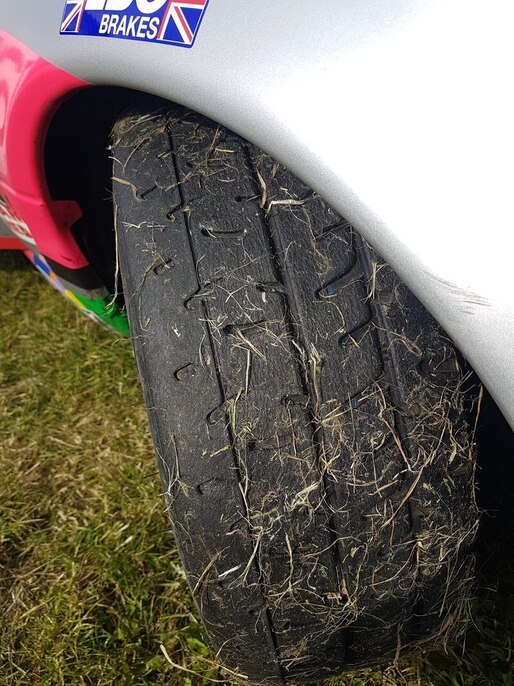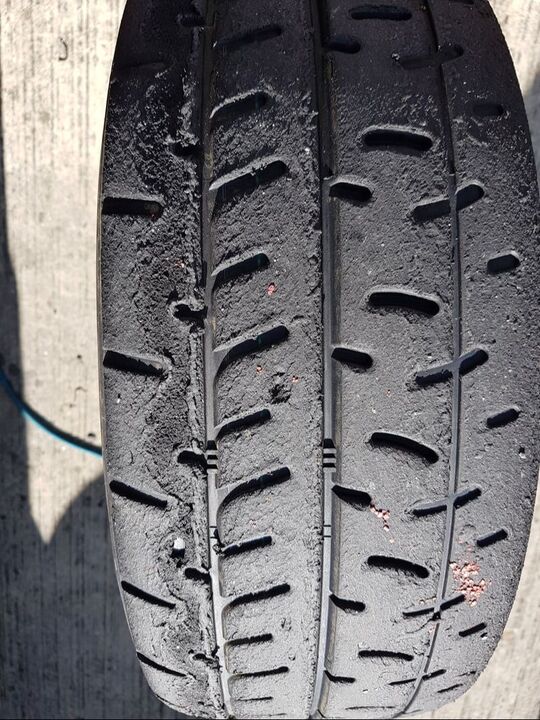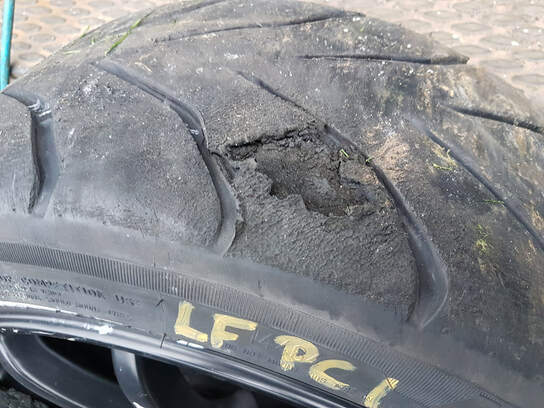Tyres can tell you a lot about your car and your driving. Check them regularly. While slick tyres may be seen as the ultimate, understand that a hard, worn out or over used slick may be slower than a softer or newer treaded tyre. Also, treaded tyres are frequently more forgiving due to the movement in the tread. As a tyre moves more towards a slick and the tread blocks become stiffer, whilst the ultimate grip may rise, the rigidity frequently means that if you exceed the overall grip the breakaway will be far more pronounced and sudden. Road tyres may not give anywhere near the ultimate grip of a circuit tyre but do give far more warning though shrieking of the impending grip limit and will let go in a far more benign way.
So, what can you diagnose by looking at your tyres? When you corner, the highest force goes on to the outer edge of the heavily loaded outer tyres. You will frequently see a little raised lump of rubber on the outside edge of a tread groove (the inside edge of a tread block). This is because the very edge of the tread block is unsupported, and it folds into the tread void so the rubber does not wear in the same way as the rest of the block. Equally, the inside edge of the block on the other side of the void will be worn and rounded down because it is the first part of the tread block taking the load and therefore takes the most heat. This is normal.
The same principal applies to acceleration and braking loads. Under braking the axial grooves (the ones going across the tread) fold on the trailing edge and wear on the leading edge of the block. Looking from the top, if the lip is on the front edge and the wear on the back edge and is heavy or abnormal, this will point to issues with braking. Traction issues will be the opposite way around (so lip on the back edge and wear on the front) and if abnormal can point to wheel spin and heavy right foot out of corners. Just remember however, whilst on road tyres it is desirable to get even wear across the whole tread width, for circuit driving, that contact patch moves around and wear on the outer face of the tyre ahead of the middle and inner sections is to be expected.
So, what can you diagnose by looking at your tyres? When you corner, the highest force goes on to the outer edge of the heavily loaded outer tyres. You will frequently see a little raised lump of rubber on the outside edge of a tread groove (the inside edge of a tread block). This is because the very edge of the tread block is unsupported, and it folds into the tread void so the rubber does not wear in the same way as the rest of the block. Equally, the inside edge of the block on the other side of the void will be worn and rounded down because it is the first part of the tread block taking the load and therefore takes the most heat. This is normal.
The same principal applies to acceleration and braking loads. Under braking the axial grooves (the ones going across the tread) fold on the trailing edge and wear on the leading edge of the block. Looking from the top, if the lip is on the front edge and the wear on the back edge and is heavy or abnormal, this will point to issues with braking. Traction issues will be the opposite way around (so lip on the back edge and wear on the front) and if abnormal can point to wheel spin and heavy right foot out of corners. Just remember however, whilst on road tyres it is desirable to get even wear across the whole tread width, for circuit driving, that contact patch moves around and wear on the outer face of the tyre ahead of the middle and inner sections is to be expected.
Front right showing a normal wear pattern after a 2-hour race at the anticlockwise Rockingham Circuit. Raised lip on outer and front edges of tread blocks from cornering and braking.
Tyre from the same race showing same wear patterns. Note the shoulder showing that most load is taken on the outer edge of the tyre.
A blistered front right soft compound tyre. This is caused by overheating. This is a relatively powerful front drive car. The camber set up was too aggressive, noted by the usual patternation on the inner (left hand as viewed ) edge and the dusty “scraped” appearance on the right combined with aggressive throttle use and wheel spin on corner exit with the raised lips on the tread blocks showing on the rear edges and wear on the front. (Tyre rotating upwards as viewed) The smaller tread blocks have overheated. This can be alleviated to some extent by reducing camber, but also a less aggressive corner exit. Ultimately a harder tyre is required.
A case of blistering causing large sections of rubber to separate. The left front from a rear wheel drive car and therefore not traction related. The large raised lip on the blistered block on the left indicates braking with the worn edge to the right showing wear. The absence of the same heavy lip on other blocks showing normal braking wear stongly suggests this damage is likely a braking lock-up causing extreme localised heat or a succession of braking issues leading to the same result.





